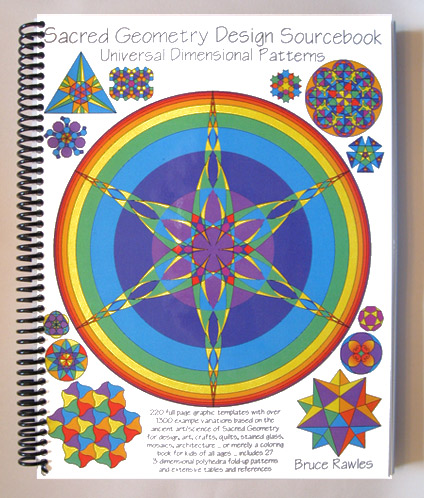
- Publisher: Elysian Publishing
- Editor: Bruce Rawles
- Available in: Spiral Bound
- ISBN: 978-0-9656405-8-9
- Published: Tuesday, 23 December 1997
Sacred Geometry Design Sourcebook is a resource and reference book with over 1300 geometric designs for kids and adults (makes a fantastic coloring book), educators, home-schoolers, mosaic and mandala artists, quilters, stained glass artisans, hobbyists, Origami crafters, 3D model makers, tiling designers, landscapers, architects, or anyone that is curious about mystical and universal geometric patterns. These geometric patterns and designs (many referred to as Sacred Geometry in recent years) occur abundantly in nature, in countless masterpieces of art and architecture over many millennia, and have captured the imagination of luminaries such as Leonardo da Vinci, Pythagoras, Plato, Kepler, Einstein, my colleagues, and fellow authors and countless others. We’re all fascinated by what seems at first (to the uninitiated) to be an arcane mathematical study, but later reveals itself to be an inquiry into the simple unity of all life, expressed in an infinite variety of forms representing the principle of interconnectedness. Even popular works like the DaVinci Code by Dan Brown have popularized the subject. If you want a great ‘hands-on’ sourcebook, read on! Sacred Geometry Design Sourcebook introduces the ancient art and science of Sacred Geometry – the easy way: whole-brain play and creative exploration. This 256 page, 8.5 by 11 inch, spiral bound (for easy photocopying) book is a reference of full-page line art graphic images and ready-to-use templates. In addition to a large collection of 2-dimensional patterns, a coloring book for kids of all ages, there are 27 3-dimensional fold-up patterns for creating exquisite shapes. These patterns and designs have been revered by pioneers and geniuses through the ages in painting, sculpture, architecture, physics, botany, materials science, crystallography, and many more arts and sciences. There is a brief introductory section on the philosophical perspective of universal proportions and symbols. The book also has extensive tables, weblinks and a bibliography for those whose curiosity has been sparked by the hands-on, experiential majority of the book; a reference for serious students of geometry.